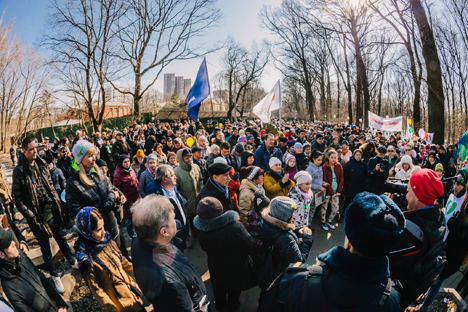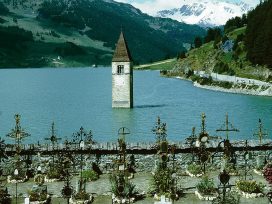When the British geologist Roderick Murchison visited Russia in the 1840s, he is reported to have expressed to Nicholas I his surprise at “the speed with which forests are being destroyed in Your Highness’ delightful country”. A visitor in 2016 might well say the same of Russia’s at least occasionally delightful capital, Moscow. In the last fifteen years, by one estimate, the city has lost some 700 hectares of green space and untold numbers of trees to development – and as reports on social media and interviews on local radio stations attest, the felling has yet to stop.
Nor, however, do residents’ protests. The most famous conflict in recent years surrounded Khimki forest in northwest Moscow, an old-growth forest fallen victim to a modern Moscow-Petersburg highway (constructed by the French construction firm Vinci). Citizen resistance to the destruction of Khimki was led by Evgeniia Chirikova, who went on to win a Goldman prize for environmental courage. Chirikova is however not alone – just as the assault on Khimki is not the only instance of aggressive and often secretive action against Russian urban woodlands. By one recent estimate there are at present at least 40 ongoing conflicts over open space in Moscow alone. If anything, citizens’ actions are becoming more well-organized and articulate, as they make common cause and draw on what seems to be a stubborn Russian affection for trees. Nikolai Nekrasov, a nineteenth-century civic poet whose verse still forms part of required curricula in schools, expressed some of that affection in his 1858 poem “Sasha,” which describes a young girl’s tears at the destruction of a woodland. In ways reminiscent of the poet John Clare’s anguished, angry evocation of the joys of meadowland lost to enclosure, Nekrasov’s forest is a place of beauty and sustenance, and not just for humans: owls and cuckoos survey what has become a battlefield, where trees lie like corpses and a frantic jackdaw searches for her children. Sentimental perhaps, but also suggestive of cultural and affective traditions that have refused to see natural landscapes merely as part of a utilitarian calculus. The Muscovites who have been protesting the loss of woodlands are Nekrasov’s children, and they have a heritage of protest to back them up – even if they may not be wholly aware of it.
Public awareness of environmental destruction first emerged in Russia in the nineteenth century, in the years following Murchison’s visit and his remark about the extent of the country’s deforestation. In a vast country that depended overwhelmingly on wood for energy (and in an overwhelmingly peasant country where traditional dwellings and almost all implements of livelihood and daily life were made of wood), there were few other options – although at the end of the century Anton Chekhov’s forest-loving doctor, Astrov, would lament that Russians didn’t use peat rather than wood in their overheated homes. Nonetheless, a broad range of commentators – economists, agronomists, and the country’s nascent professional foresters – increasingly expressed dismay at the impact of deforestation on agriculture and the navigability of rivers, and at the country’s squandering of a resource that had too easily been regarded as “limitless.” Astrov’s statement that deforestation changes climate (an observation that should catch the ear of any twenty-first century theatregoer) had been a matter of discussion in the Forest Journal for decades, as had studies of the relationship between the felling of woodlands and arid conditions and soil erosion. Increasing numbers of Russian scientists and writers called for action to conserve the country’s European forests.
Restrictions on access to forestland had first been initiated by Peter the Great, for whom trees represented naval stores; one nineteenth-century commentator in fact referred to Peter as the country’s “first forester.” In the early nineteenth-century German foresters arrived to manage Russian forests, and by the middle of the century Russians were being sent to Germany to study, returning to Russia to conduct field research of their own on deforestation and its impact on river systems, soil health and micro-climate. Much of this rich tradition of forestry continued into the Soviet era, when the distinct approach to forest ecology that had been developed by Georgii Morozov continued, if quietly and indirectly, in the work of his students.
But the work of defending Russia’s woodlands was not left to her scientists. This emerging body of scientific knowledge was presented in nineteenth-century literature, journalism and visual art by writers and artists who drew on folk traditions and the rich moral vocabularies of Russian literate culture to raise alarm and evoke concern. The chorus of voices debating what by the 1860s was called the “forest question” included poets like Nekrasov, writers like Tolstoy (and even the urban Dostoevsky), conservative antiquarians and civic activists. By century’s end there were voices from within the Orthodox church calling for conservation of forests; one parish priest in the Orel district resorted to a ritual of sanctification in an attempt to protect a village woodlot. The economic fallout from the 1861 emancipation had made things worse, setting off a kind of “wood rush” of landowners selling forests for quick cash, a scenario described in Anna Karenina, in which the cash-strapped Stiva sells off his wife’s woodland, much to the dismay of Levin, who insists he should count every tree – a form of intimate acquaintance in which the bon vivant is clearly uninterested. In 1888 an ambitious (if ultimately poorly implemented) Forest Law was promulgated, and by the time of the revolution there was strong enthusiasm among forestry professionals for the new regime, hoping as they were for a more rational approach to the management of the country’s huge resource.
Nineteenth-century Russian artists and intellectuals engaged in prolonged discussions about Russian identity and Russia’s relationship to Europe, and questions about the forest and its future were inevitably drawn into this process. American environmental images and sensibilities have emerged primarily from writers’ and artists’ response to a supposedly new and unpeopled continent; one thinks of John Muir and the Hudson school painters, whose visions of “sublime” landscape and raw wilderness evolved from European romanticism and the canvases of artists like Caspar David Friedrich. Russian artists anguished over the lack of a sublime in their native land. In the period from 1850 to the turn of the century, artists responded with an aesthetic that celebrated a “meager” and distinctly non-sublime nature, one that almost always showed evidence of human – peasant – life and culture. The fate of nature and the fate of humans were deeply intertwined in these canvases. By the 1880s, Ilya Repin’s monumental Procession of the Cross in the Kursk District made an explicit parallel between the violent destruction of woodlands (evident in the background) and police violence against the populace – all cloaked in religious hypocrisy. (Repin’s work on the painting was deeply informed by his visit to a site where a beloved oak wood had recently been cut down.) Repin’s Procession of the Cross and Ivan Shishkin’s Among the Spreading Vale both echo traditional peasant culture, in which trees were often regarded as sentient companions of grief, stalwart sufferers, or emblems of righteousness. While the birch is most famous as a natural icon of Russia, traditional peasant culture included a broad array of symbolic meanings for particular tree species, meanings that Russian poets have richly drawn on. A particularly famous and beautiful example of this is Boris Pasternak’s representation of a rowan tree as a figure of self-sacrifice in Doctor Zhivago.
Defense of woodlands and resistance to the destruction of urban parkland did not end with the arrival of Soviet power, and while nineteenth-century writers and scientists had focused primarily on European Russia, their twentieth-century successors expanded their concern to the vast forests of Siberia. The environmental historian Douglas Weiner makes this abundantly clear in his magisterial studies of conservation efforts and zapovedniki (tracts of land, often wilderness, set aside for scientific study; while they rival the US national parks in their size, they are more strictly protected, since they are not by definition open to tourism). But while much of Weiner’s narrative revolves around scientific elites, there were at least some instances of civic action undertaken by non-scientists, aiming at the protection of cherished landscapes.
There is much more to be discovered and related about such actions in various Soviet Republics. Close to Moscow, such protests included complaints about trees dying at Tolstoy’s estate in the late 1960s, as a result of emissions at a nearby chemical plant; and protests by a group of local citizens in Orel in the early 1970s, dismayed at the destruction of a beloved linden alley in the city park, cut down when the square in front of communist party headquarters was expanded. While that protest came after the lindens had already been destroyed, later efforts to defend a centuries-old oak from a road-widening plan were successful.
Stories like these are, almost by definition and certainly within the Soviet context, difficult to tell. They are local, often hidden versions of the much-more widely publicized campaign for Baikal that took place in the late 1960s, which may well have emboldened local conservationists. Examples of an impulse to protect and preserve, they show a willingness to challenge authority on behalf of cherished places. In the case of Tolstoy’s estate, the huge cultural authority of the writer, and the fact that it was a tourist destination within easy reach of Moscow, meant that museum staff had some leverage in challenging a local industrial concern – and hence the rigid logic of five-year plan economics over environmental wellbeing. It’s not clear that arguments grounded in public health concerns (if trees are dying, what’s happening to human populations?) would have been successful. In Orel, the linden alley was associated both with private memories and with the city’s rich literary history; the expanded square that replaced it made Orel more like every other provincial city, with a mini-Red Square in pale imitation of Moscow. Both of these examples are linked to cultural, and specifically literary history and are woodland analogues of campaigns to preserve cultural monuments that emerged in the Soviet Union in the 1980s. Those campaigns, spearheaded by the literary historian Dmitrii Likhachev, rallied to protect architectural monuments, “cultural environment” that were just as important as natural environments for humankind.
Of the forty or so points of conflict ongoing in Moscow today, the one that has perhaps garnered the most attention is Dubki Park, located in the Timiriazev district on the city’s near north side. A small (40-acre) tree-lined oasis in a neighbourhood of Soviet-era apartments, the park’s name (“oak groves”) derives from an alley of oak trees that are one of its main features. Conflict over the park erupted suddenly in early March of this year, with the erection of high fencing and the unannounced felling of 35 trees, mostly old oaks, all in preparation for the construction of a 75-metre apartment building slated to include two levels of underground parking. Dismayed residents quickly organized, submitting petitions to local municipal authorities, gathering scientific reports on local ground water, and using the whole array of social and traditional media to publicize both construction plans and their protests. Their protests have included organized rallies and around-the-clock surveillance of the construction site, which have led to repeated altercations both with the construction firm’s security guards and Moscow police.
Dubki Park matters to those protesting its destruction for a whole host of reasons, and they have used a rich array of arguments to make their case – arguments that are both cultural and ecological. They highlight the park’s importance to residents as a rare oasis of green in a densely-built neighborhood; they emphasize the illegality of the building, whose height violates the city’s master plan, and ways in which established procedures (including public hearings) have not been followed. They note the park’s status as a “Monument of Landscape Architecture and Cultural Significance,” which designates official protection and the site’s cultural value. There had been a childcare centre adjoining the park, and the new building would be in clear violation of existing laws about such centres – which are, in short supply in this part of Moscow. They also reference specifically environmental concerns, noting a 2005 report on local hydrology as evidence that digging for a two-level underground parking facility will fundamentally undermine the ground water and prove fatal to the park’s remaining trees. Supporters’ reports regularly note the age of the trees, including many of those already chopped down. All of these lines of argument suggest an informed, well-conceived approach, one that argues for the park’s value using multiple registers – scientific, legal, and historical.
There is also a strong “rule of law” argument in the repeated insistence that procedures and statutes have been violated; again and again, defenders of the park make appeals to existing laws and regulations. As one participant puts it, “for many people Dubki has by now become a symbol of the struggle for our rights, and against corruption. To preserve the park means to win a victory over unprincipled bureaucrats, and to demonstrate that our laws work for our people – and not against them.”
But in addition to this, there has been an effort – particularly in public demonstrations – to draw on powerful cultural traditions that add an emotional and moral dimension to the actions. I first became aware of events at Dubki when a friend posted a photograph on her Facebook page, of Muscovites forming a “funeral procession” for the 35 trees that had been cut down. Video of the procession posted on YouTube shows a long train of quiet marchers, young and old, men and women, still in winter coats, many of them carrying small signs emblazoned with the number of a tree among those that had been cut down, an indication of its species (oak, spruce) and the date of its death – March 1, 2016. At the head of the procession, a woman in a green wool beret carries a picture of the still-tree-filled park, and explains what they are doing: honouring the memory of the trees, some as much as 150 years old, who had outlived generations of human residents of the neighbourhood; trees which were, as she puts it, “innocent” when someone decided they wanted to make “big money”. As later becomes clear in this video account, letters to Moscow’s mayor, Sergei Sobyanin, sent before the trees were cut down, had gone unanswered. And so citizens organized the funeral, as an act of memory and challenge.
There is a long and important tradition of funerals as protest in Russia, from nineteenth-century and revolutionary-era processions to the great gatherings on the death of poets like Anna Akhmatova (or Nekrasov), funerals that became de facto political protests. The Dubki funeral also echoes the long-standing cultural association of humans and trees – not unlike Repin and Shishkin’s paintings – ascribing to trees both individuality (each one has its own gravestone and marker) and a kind of sentience. The American legal scholar Christopher Stone launched a discussion in the 1970s about whether trees (and other natural objects) should have legal standing, a discussion that has been important for environmental ethicists in the US and elsewhere. In a country where the standing of human citizens before the law is both troubled and dubious, it’s hard to know whether trees should have standing, and if it would matter. The Dubki protesters are nonetheless making arguments that are both legal and cultural, actions offered as evidence in a trial for public opinion. Drawing on histories of place and the Russian literary tradition, commentators have pointed to the neighbourhood’s history as a dacha region. In one of those small summer houses (according to one post), Boris Pasternak wrote, “A Candle Burned on a Table”, a poem from Doctor Zhivago. One account of protests that I encountered suggested that a candle-lit march was inspired by that connection.
In a recent story about Moscow protests over the loss of green space, an American reporter refers to “several hundred environmentalists” gathered in Dubki park. What does it mean to be an environmentalist these days in Russia? Angelina Davydova, a St. Petersburg-based journalist covering environmental issues since 2008, claims in a December 2015 Guardian article that despite recent clampdowns, “environmental messages are slowly gaining traction in Russia”, and that a “growing number of civil society movements and initiatives” are evident – often dealing with local disputes. Do the Dubki park defenders think of themselves as environmentalists? Ksenia Kirillenko, in her account, describes “young mothers with baby carriages, school children and university students, creative intelligentsia and middle-aged academics, along with all concerned residents of the Timiriazev district”. The protests around Dubki, like other recent protest actions by citizens against the corrupt and soul-destroying destruction of beloved places, demonstrate creativity, deep feeling, and a sense even among urban dwellers that trees are companions and living beings. They also demonstrate a passionate and meticulous attempt to insist on the rule of law.
The political aesthetic invoked in these and other protests suggests a kind of “mashup” – combining traditions of civic courage with iconic rhetoric and ritual, all retrofitted for post-Soviet Russia. Other examples of this come to mind. In 2000, the Petersburg newspaper Chas Pik ran an image that overlaid two iconic Russian paintings – one by Repin, the other by Shishkin – above a column urging restoration of the country’s environmental agency (which had been dissolved by Putin). The image show the members of Russia’s parliament sitting in a woodland, as though the trees themselves might be the ultimate lawgivers. The accompanying article quoted Nekrasov and his weeping Sasha. Nine years later, in 2009, at a St. Petersburg rally held to protest the proposed construction of a Gazprom skyscraper in the city centre, one woman’s sign updated the Bolshevik slogan “All Power to the Soviets” to read “All Power to the laws“. Another protester held a sign with Dmitrii Likhachev’s picture on it; above the crowd, the distinguished academic faced down another placard with an image created from a collage of Gazprom drawings and the Eye of Sauron from Tolkein’s Lord of the Rings.
Russian legal scholars Aleksey Anisimov and Anatoly Ryzhenkov have recently argued that Russian environmental law is “inefficient” due to its adherence to a “mechanistic perception of the world held by those at the helm of political power.” They appeal to Albert Schweitzer, among others, as a way to overcome a “simplified understanding of the complex interaction between society and nature and constant natural processes,” and call for a “radical change in the worldview” of residents of the former Soviet Union. While Anisimov and Ryzhenkov’s analysis of Russian legal mechanisms may be correct, they ignore, it seems to me, important Russian traditions of environmental concern and care – traditions that activists in the trenches regularly draw on, whether they’re holding funerals for trees or invoking civic poets. The American conservationist Aldo Leopold famously argued that anything as important as an environmental ethic is never written down; more recently, the American legal scholar Jedediah Purdy has argued for the role of imagination in expressing environmental value. “Imagination is less precise, less worked-out, more inclusive than ideas, and it belongs to people in their lives, not to philosophers working out doctrines. Imagination is a way of seeing, a pattern of supposing how things must be.” What’s so interesting – and dare one say, inspiring of hope – is how groups like the defenders of Dubki are making methodical, meticulous appeals to both law and scientific testimony, but also forging an imaginative, culturally-inflected form of civic action to protect both human and more-than-human lives.







